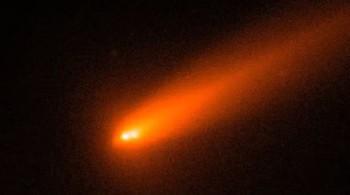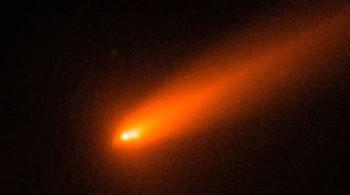
Comet C/2025 K1 (ATLAS) breaks into 3 after coming close to Sun
In a remarkable astronomical event, Comet C/2025 K1 (ATLAS) has broken into three pieces after swinging too close to the Sun. This extraordinary occurrence was captured by astronomers using Italy’s Copernicus telescope, providing a unique glimpse into the comet’s dramatic transformation. The comet’s nucleus became unstable after it passed close to the Sun on October 8, resulting in a spectacular split that has left scientists fascinated.
Comet C/2025 K1 (ATLAS) was first discovered in May 2025 by the ATLAS (Asteroid Terrestrial-impact Last Alert System) survey, a NASA-funded project designed to detect near-Earth asteroids and comets. Initially, the comet was thought to be a single, intact object, but as it approached the Sun, its behavior became increasingly erratic. As it drew closer to the Sun, the comet’s ices began to vaporize, creating a bright tail of gas and dust that stretched millions of kilometers into space.
The comet’s close encounter with the Sun, known as perihelion, occurred on October 8, when it came within 1.2 astronomical units (AU) of the Sun’s center. One astronomical unit is the average distance between the Earth and the Sun, approximately 149.6 million kilometers. As the comet approached the Sun, its surface temperature soared, causing the ices to sublimate (change directly from a solid to a gas) and creating a massive amount of gas and dust.
The intense heat and gravitational forces exerted by the Sun caused the comet’s nucleus to become unstable, ultimately leading to its break-up. The resulting fragments, two large chunks and a smaller third piece, are now drifting apart, with the two main fragments separated by approximately 2,000 kilometers. The smaller piece can be seen to the left of the pair, a testament to the violent forces that tore the comet asunder.
Astronomers were able to capture stunning images of the comet’s break-up using Italy’s Copernicus telescope. The telescope, named after the famous astronomer Nicolaus Copernicus, is a 1.2-meter reflector telescope located in Italy’s Tuscany region. The images reveal the comet’s fragmented nucleus, with the two main pieces appearing as distinct, bright objects, while the smaller third piece is visible as a fainter, more diffuse spot.
The break-up of Comet C/2025 K1 (ATLAS) is a rare and significant event, offering scientists a unique opportunity to study the internal structure and composition of a comet. By analyzing the fragments and their behavior, researchers can gain valuable insights into the comet’s origins and evolution, as well as the processes that govern its disintegration.
Comets are icy bodies that originate from the outer reaches of the solar system, and their study can provide important clues about the formation and evolution of our cosmic neighborhood. The break-up of Comet C/2025 K1 (ATLAS) serves as a reminder of the dynamic and unpredictable nature of comets, which can undergo sudden and dramatic changes as they interact with the Sun and other celestial objects.
As the fragments of Comet C/2025 K1 (ATLAS) continue to drift apart, astronomers will be closely monitoring their behavior, searching for signs of further break-up or other unusual activity. The study of this comet’s demise will undoubtedly provide valuable insights into the workings of our solar system, and the complex, often violent processes that shape the objects that inhabit it.
In conclusion, the break-up of Comet C/2025 K1 (ATLAS) is a remarkable event that has captivated astronomers and space enthusiasts alike. The stunning images captured by Italy’s Copernicus telescope offer a unique glimpse into the comet’s dramatic transformation, and the scientific community will undoubtedly be eagerly following the fragments’ progress in the coming weeks and months.




